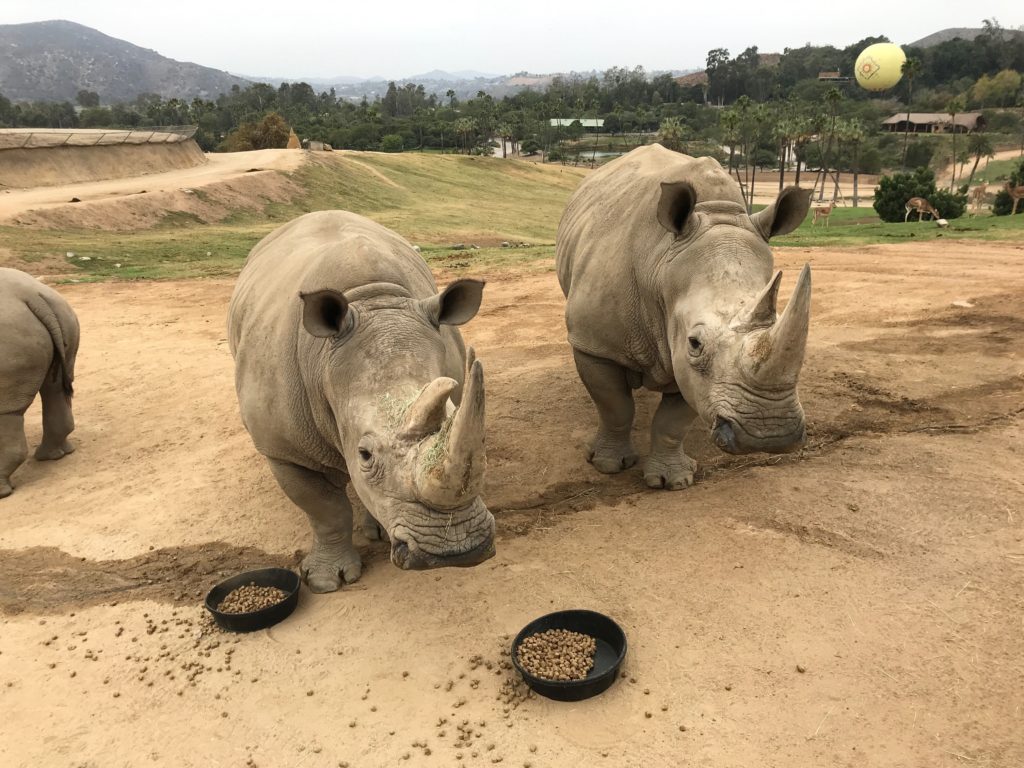
Safari Park keepers are often asked what the job is like. That varies, depending on the animals one cares for, but let me give you a tiny peek at what it's like to feed rhinos!
It’s 7 a.m. on a beautiful summer morning. The sun has peeked above the horizon and all is calm in the East Africa habitat at the Safari Park. The keeper truck is loaded with bales of hay and bags of pellet. Two of us work quickly to fill tubs with a special kind of pellet reserved for our crash of southern white rhinos. With the pellets divided among 11 tubs, we set off to feed these, the largest animals in the exhibit. With one keeper driving and another on the back this isn’t always as easy as it sounds.
Southern white rhinos are just like people in that they have their own little social groups. When it comes to breakfast time, it is up to the keepers to strategically drop the food tubs to each rhino so no fights ensue. The last thing you want is to get between two 4,000 pound animals that want the same breakfast plate!

Slowly easing along the road we spot the first rhinos—the group we refer to as “The Three Old Ladies”. This is a special trio, and they’re not really “old” ladies. It consists of our matriarch Dumisha, 22-year-old Utamu and 4-year-old Kianga. When Kianga’s mom, Kacy, gave birth to another calf, Kianga needed companionship and the two older girls took her in. We drop the tubs to trio and slowly drive to the next two in line, where things could get tricky.
The next two are Kiazi and her daughter Ellen; they’re two of the most skittish of the crash and tend to cause the most issues. Thankfully this morning, they are content to get their breakfast and the truck moves on. Next in line is Holly and her son Masamba, but a young female, Ahadi, is trying to cut in line. Holly gives a quick yell to the “cutter” to remind her of her place. It has the right effect, Ahadi waits, and everyone gets their breakfast unscathed.
Next is our bull, J Gregory, referred to as “J”. He is a favorite of all the keepers because he is the gentlest of giants and son to long-time-resident Chuck. We take extra precautions to make sure J gets his breakfast. Although he is the largest of the rhinos he gets picked on the most. J prefers scratches to breakfast, but we still have more mouths to feed so we drop his pellet and head off in search of our last two members of the crash.
Kacy is easily recognized by her extremely long primary horn and has the youngest of our rhinos, Justin, close by. Little Justin isn’t so little anymore but Kacy still likes to keep him some distance from the rest of the morning chaos. They get their breakfast and we can breathe a sigh of relief. Feeding the rhinos in the morning doesn’t take very long but can be very stressful if things don’t go right. Now that the crash is happily eating the keepers can feed the rest of the animals on exhibit!
If you want to see more of our herd dynamics you can ride the Africa Tram for a glimpse of the crash or book a Caravan Safari for an up close look at all of our rhinos! Join us at the Park on World Rhino Day, Sunday, September 22 for keeper talks and an information table on how you can help with rhino conservation!
Charlie Hyde is a senior keeper at the San Diego Zoo Safari Park.




